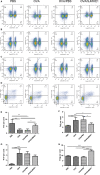Schistosoma japonicum peptide SJMHE1 suppresses airway inflammation of allergic asthma in mice
- PMID: 31496071
- PMCID: PMC6815837
- DOI: 10.1111/jcmm.14661
Schistosoma japonicum peptide SJMHE1 suppresses airway inflammation of allergic asthma in mice
Abstract
Helminths and their products can shape immune responses by modulating immune cells, which are dysfunctional in inflammatory diseases such as asthma. We previously identified SJMHE1, a small molecule peptide from the HSP60 protein of Schistosoma japonicum. SJMHE1 can inhibit delayed-type hypersensitivity and collagen-induced arthritis in mice. In the present study, we evaluated this peptide's potential intervention effect and mechanism on ovalbumin-induced asthma in mice. SJMHE1 treatment suppressed airway inflammation in allergic mice, decreased the infiltrating inflammatory cells in the lungs and bronchoalveolar lavage fluid, modulated the production of pro-inflammatory and anti-inflammatory cytokines in the splenocytes and lungs of allergic mice, reduced the percentage of Th2 cells and increased the proportion of Th1 and regulatory T cells (Tregs). At the same time, Foxp3 and T-bet expression increased, and GATA3 and RORγt decreased in the lungs of allergic mice. We proved that SJMHE1 can interrupt the development of asthma by diminishing airway inflammation in mice. The down-regulation of Th2 response and the up-regulation of Th1 and Tregs response may contribute to the protection induced by SJMHE1 in allergic mice. SJMHE1 can serve as a novel therapy for asthma and other allergic or inflammatory diseases.
Keywords: SJMHE1; Schistosoma japonicum peptide; airway inflammation; allergic asthma; suppress.
© 2019 The Authors. Journal of Cellular and Molecular Medicine published by John Wiley & Sons Ltd and Foundation for Cellular and Molecular Medicine.
Conflict of interest statement
The authors declare that they have no competing interests. The funding agencies played no role in the design or implementation of the study, analysis or interpretation of the data, or the preparation and submission of the manuscript.
Figures






Similar articles
-
Schistosoma japonicum HSP60-derived peptide SJMHE1 suppresses delayed-type hypersensitivity in a murine model.Parasit Vectors. 2016 Mar 12;9:147. doi: 10.1186/s13071-016-1434-4. Parasit Vectors. 2016. PMID: 26971312 Free PMC article.
-
Oleanolic acid suppresses ovalbumin-induced airway inflammation and Th2-mediated allergic asthma by modulating the transcription factors T-bet, GATA-3, RORγt and Foxp3 in asthmatic mice.Int Immunopharmacol. 2014 Feb;18(2):311-24. doi: 10.1016/j.intimp.2013.12.009. Epub 2013 Dec 27. Int Immunopharmacol. 2014. PMID: 24374304
-
Schistosoma japonicum peptide SJMHE1 inhibits acute and chronic colitis induced by dextran sulfate sodium in mice.Parasit Vectors. 2021 Sep 6;14(1):455. doi: 10.1186/s13071-021-04977-y. Parasit Vectors. 2021. PMID: 34488863 Free PMC article.
-
The role of the FOXP3 transcription factor in the immune regulation of allergic asthma.Curr Allergy Asthma Rep. 2005 Sep;5(5):356-61. doi: 10.1007/s11882-005-0006-z. Curr Allergy Asthma Rep. 2005. PMID: 16091206 Review.
-
Autophagy: A Friend or Foe in Allergic Asthma?Int J Mol Sci. 2021 Jun 12;22(12):6314. doi: 10.3390/ijms22126314. Int J Mol Sci. 2021. PMID: 34204710 Free PMC article. Review.
Cited by
-
Hypoxic hUCMSC-derived extracellular vesicles attenuate allergic airway inflammation and airway remodeling in chronic asthma mice.Stem Cell Res Ther. 2021 Jan 6;12(1):4. doi: 10.1186/s13287-020-02072-0. Stem Cell Res Ther. 2021. PMID: 33407872 Free PMC article.
-
Emu-miR-10a-5p in Echinococcus multilocularis-derived-extracellular vesicles alleviates airway inflammation in mice with allergic asthma by inhibiting macrophage M2a polarization through LIF-mediated JAK1-STAT3 signaling.Front Immunol. 2025 May 27;16:1577349. doi: 10.3389/fimmu.2025.1577349. eCollection 2025. Front Immunol. 2025. PMID: 40496853 Free PMC article.
-
Allergen-Specific Treg Cells Upregulated by Lung-Stage S. japonicum Infection Alleviates Allergic Airway Inflammation.Front Cell Dev Biol. 2021 Jun 8;9:678377. doi: 10.3389/fcell.2021.678377. eCollection 2021. Front Cell Dev Biol. 2021. PMID: 34169075 Free PMC article.
-
Schistosome Infection and Schistosome-Derived Products as Modulators for the Prevention and Alleviation of Immunological Disorders.Front Immunol. 2021 Feb 22;12:619776. doi: 10.3389/fimmu.2021.619776. eCollection 2021. Front Immunol. 2021. PMID: 33692793 Free PMC article. Review.
-
Microbes little helpers and suppliers for therapeutic asthma approaches.Respir Res. 2024 Jan 13;25(1):29. doi: 10.1186/s12931-023-02660-7. Respir Res. 2024. PMID: 38218816 Free PMC article. Review.
References
-
- Shi YH, Shi GC, Wan HY, et al. Coexistence of Th1/Th2 and Th17/Treg imbalances in patients with allergic asthma. Chin Med J. 2011;124:1951‐1956. - PubMed
-
- Gilchrist FJ, Ahmad AN, Batchelor HK, Marriott JF, Lenney W. A review of prednisolone prescribing for children with acute asthma in the UK. J Asthma. 2016;53:563‐566. - PubMed
-
- Choby GW, Lee S. Pharmacotherapy for the treatment of asthma: current treatment options and future directions. Int Forum Allergy Rhinol. 2015;5(Suppl 1):S35‐40. - PubMed
Publication types
MeSH terms
Substances
LinkOut - more resources
Full Text Sources
Medical
Molecular Biology Databases
Research Materials
Miscellaneous

